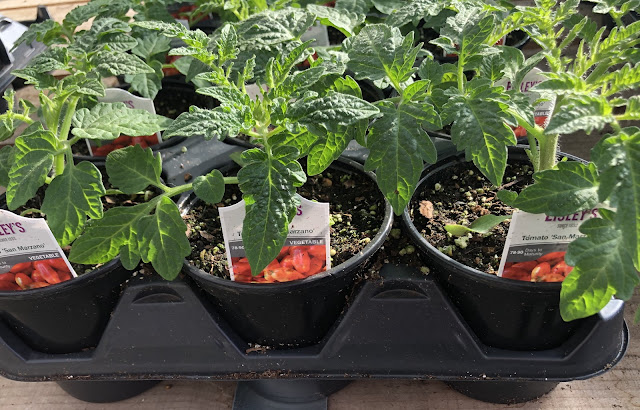
Soil temperature is key to transplant success

|
|
Just because they're in the nurseries doesn't mean it's time to plant tomatoes.
These likely were greenhouse-grown, meaning they really need ideal (warm)
soil conditions to get growing. (Photo: Kathy Morrison)
|
“Can I plant tomatoes now?”
Record warm days have prompted that thought among many Sacramento-area gardeners. Super Bowl Sunday proved to be the hottest February day ever recorded in Sacramento – 78 degrees.
Following several springlike days in the 70s, plants (and people) are responding to this warmth as if it’s April, not mid February. Spring flowers are quickly coming into bloom. Some local nurseries have already started putting out tomato seedlings for sale.
But that doesn’t mean it’s time to transplant those baby tomato plants outside – into the cold, hard ground. Because that soil is still mighty chilly.
According to the UC Davis weather and climate report, soil temperature was still only 51 degrees at its campus weather station Sunday. That’s typical for late winter/early spring. Afternoon air may be warm, but overnight temperatures are still dipping down into the 40s.
Tomatoes need warm soil to grow, develop strong roots and thrive. Transplant a tomato seedling into cold soil, it will just sit there and sulk (or worse).
Ideally, tomatoes and other summer crops such as peppers, squash and eggplant need soil temperatures above 60 degrees before transplanting. Tomatoes prefer soil temperatures even warmer. Oregon State University researchers found that soil temperatures in the 65- to 70-degree range were the sweet spot for tomato transplanting.
When will we see soil temperatures that warm? Most likely April, say the weather forecasters. April also is Sacramento’s traditional tomato transplanting time.
The best way to know for sure in your own garden is to use a soil thermometer. Available at nurseries, this simple device can check soil temperature at a glance; just stick it in the ground. (It’s a lot like checking the temperature of a roast in the oven with a meat thermometer.)
Soil in raised beds warms faster than soil in level ground. The same goes for soil that gets reflected heat from concrete walks or buildings. Wherever, our soil is still not going to reach 60 degrees for at least four to six weeks, say soil experts.
A lot of weather can happen between now and April. Sacramento’s historical frost date – the last day with a threat of freezing overnight temperatures – is March 23. Baby tomato plants also don’t cope well with heavy rain. A March miracle with 3 or more inches of rain would definitely help our water outlook, but could cause any early transplants to damp off in cool, wet soil.
So, wait on the tomatoes for now, and concentrate on leafy greens instead. Your salad garden may not have extra-early Early Girls, but there’s still time to plant more lettuce.
Comments
0 comments have been posted.Sacramento Digs Gardening to your inbox.
Sites We Like
Garden Checklist for week of July 21
Your garden needs you!
* Keep your vegetable garden watered, mulched and weeded. Water before 8 a.m. to reduce the chance of fungal infection and to conserve moisture.
* Feed vegetable plants bone meal, rock phosphate or other fertilizers high in phosphate to stimulate more blooms and fruiting. (But wait until daily high temperatures drop out of the 100s.)
* Don’t let tomatoes wilt or dry out completely. Give tomatoes a deep watering two to three times a week.
* Harvest vegetables promptly to encourage plants to produce more. Squash especially tends to grow rapidly in hot weather. Keep an eye on zucchini.
* Pinch back chrysanthemums for bushy plants and more flowers in September.
* Remove spent flowers from roses, daylilies and other bloomers as they finish flowering.
* Pinch off blooms from basil so the plant will grow more leaves.
* Cut back lavender after flowering to promote a second bloom.
* It's not too late to add a splash of color. Plant petunias, snapdragons, zinnias and marigolds.
* From seed, plant corn, pumpkins, radishes, winter squash and sunflowers.